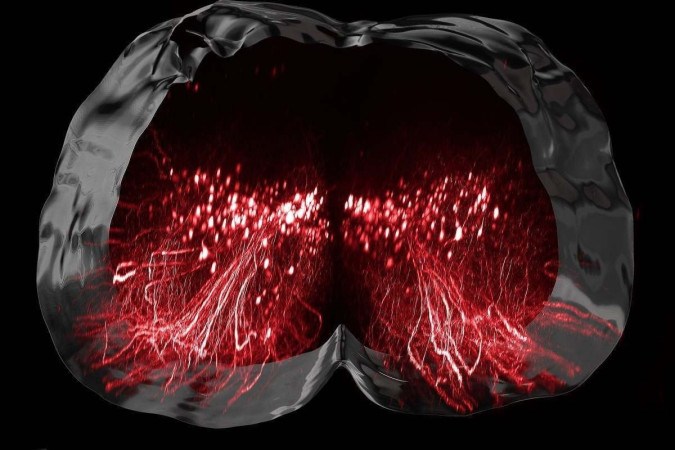Published on 10/11/2022 06:00

(Credit: NeuroRestore/Disclosure)
Nine people with severe or complete paralysis due to spinal cord damage were able to walk again after receiving electrical stimulation in a specific group of neurons. In a study published in Nature, researchers at the Swiss Federal Institute of Technology in Lausanne described the cells responsible for restoring walking in these patients, which they named SCVsx2::Hoxa10. According to the scientists, the identification of these structures is a major step in the rehabilitation of movement therapy.
The neurons described are a subset of cells known as V2a, found in the brain stem and spinal cord. It is already known that they are involved in various aspects of locomotion and limb movement in people without injuries to the area. However, the group’s main role in restoring walking was not yet known.
The nine patients in the article have been involved for some time in a study of epidural electrical stimulation (EES), a technique developed half a century ago to relieve back pain. The method mainly consists of implanting electrodes under the muscle and bone over the dura mater – the outer membrane of the nervous system. These devices release electrical currents that are able to activate nerve cells in the spinal cord. Therefore, this approach has recently been used in motor function rehabilitation research.
In the Neurorestore laboratory at the Swiss Federal Institute of Technology, the scientists, led by Grégoire Courtine and Jocelyn Block, used EES in six seriously injured people — when some nerve connections are still preserved despite the absence of movement — and in three completely paralyzed people. For five months, patients underwent treatment, based on a new electrode developed by the team. While receiving stimulation, everyone was able to walk with the help of a robotic support.
Engine advance
What caught the scientists’ attention, however, was that even after the neurorehabilitation process and the cessation of stimulation, all patients continued, to a greater or lesser extent, to make progress in motor function. This indicates that the nerve fibers that muscles use for walking have been reorganized. The researchers then sought to find out how this happened, and information they say is needed to develop more effective treatments for people with spinal cord injuries.
The team used mice with the same spinal injuries as the patients and electrically stimulated the animals’ spinal cord. Using a technique called optogenetics, the scientists were able to turn specific cells on and off during the process. They found a subset of neurons that, in healthy mice, were not needed for locomotion, but in injured mice, they were essential for restoring motor function.
“We have created the first 3D molecular map of the spinal cord,” neuroscientist Gregoire Courtine said in a statement. According to him, this was the first time that researchers were able to visualize spinal cord activity in motion. “Our model allows us to monitor the recovery process with an improved degree of detail, at the neuronal level.” Thus, the team realized that, after being electrically activated, SCVsx2::Hoxa10 cells were reorganized, allowing movement despite spinal cord injury.
Neuroscientist Stephanie Lacour, of the Swiss Federal Institute of Technology, validated the research with epidural implants developed in her lab. The system allowed not only to stimulate the spinal cord, but also to selectively deactivate a group of neurons that the researchers believe is key to rehabilitation. This turned out to be true: when these cells “switched off”, the mice immediately stopped walking. In healthy animals, the process itself had no effect, implying that SCVsx2::Hoxa10 is directly related to neural reorganization in patients with spinal cord injury.
More studies
“It is essential for neuroscientists to be able to understand the specific role that each subpopulation of neurons plays in a complex activity such as walking,” Jocelyn Bloch, a neurosurgeon at Lausanne University Hospital and co-author of the article, said in a note. . “Our new study, in which nine patients were able to restore a certain degree of motor function thanks to the implants, gives us important information about the process of reorganizing neurons in the spinal cord. We can now attempt to manipulate these neurons to regenerate the spinal cord.”
“The authors exercise caution because, given the complexity of the types of cells in the spinal cord, they consider that this is only one of those involved in the process, and that there may be other groups of neurons involved in different aspects of recovery,” Juan de los points out. Reyes Aguilar, a researcher from the Experimental Neurophysiology and Neurocircuitry Group at the National Hospital for Paraplegics in Spain, who was not involved in the study. “They also recognize that the work (identifying neurons) has been done in animals, and it is possible that there are different types of cells between different species. Therefore, it will be necessary to emphasize later, in post-mortem tissues from humans, that the modification of These neurons through the effect of epidural therapy,” he said.
However, Aguilar highlights that “the prospects for better outcomes are very good and feasible.” “The strides that Curtin’s group has taken in this area have been solid, and this work is an important advance built on a large base of knowledge, with the potential to improve rehabilitative treatment for people with spinal cord injuries. Optimization of therapies can be achieved through a combination of suprastimulation and Dura implants have better and appropriate stimulation protocols to generate more lasting effects,” he says.



![[VÍDEO] Elton John’s final show in the UK has the crowd moving](https://www.lodivalleynews.com/wp-content/uploads/2023/06/Elton-John-1-690x600.jpg)


More Stories
What ChatGPT knows about you is scary
The return of NFT? Champions Tactics is released by Ubisoft
What does Meta want from the “blue circle AI” in WhatsApp chats?